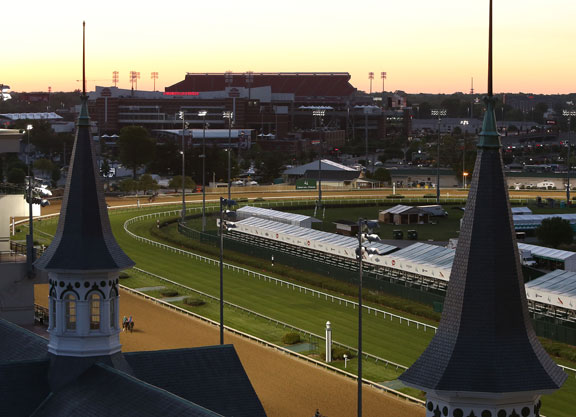By Brianne Sharp
As the only 20-horse race in the country, post position matters far more in the Kentucky Derby than in any other race. Entries will be taken for the 2018 Derby Tuesday, and except for the moment when the gates fly open next Saturday, the most nerve-wracking moment for the connections of the Derby runners will be the post-position draw. Every owner, trainer, and jockey will be holding their breath when the number one pill is pulled, crossing their fingers that their horse's name isn't called.
It doesn't have to be this way.
In car racing, the driver with the best qualifying time gets pole position. In the NCAA basketball tournament, teams are seeded from one to 16–teams with better resumes getting better seeds. In swimming, the fastest qualifiers start from the center lanes where there is less turbulence and they can easily see all of their competition. In each of these sporting events, the top qualifiers earn a better starting position.
Let's do the same thing with the Kentucky Derby.
From 1998 to 2009, Churchill Downs used a two-tiered draw which allowed connections of Kentucky Derby horses to choose their post positions, but the order of selection was based on a random draw. I think Churchill should go back to the “choose your own post” system, but they should use the Derby points standings to determine the order in which connections get to choose. The horse with the most points gets to go first, the #20 horse goes last. The draw could be televised live on NBC Sports Network and it would be a lot more interesting than the traditional “pill pull” draw.
This year, top qualifier Magnum Moon (Malibu Moon) would have first choice, and, barring any other defections from the top 20, Instilled Regard (Arch) would have 20th choice and would likely end up in post one. The one-hole would almost certainly be the last post position chosen each year, as it has been a clear disadvantage in recent years with 20-horse fields due to bumping from outside horses trying to get over to save ground. The last horse to win from post one was Ferdinand in 1986 (there were only 16 horses in the Derby that year) and the last horse to finish in the top three from post one was Risen Star in 1988. Since 2000, the best finish for a horse breaking from the one was Sedgefield, who finished fifth in 2007. The lowest post position to win the Derby since 2000 was Super Saver from post four in 2010.
Some might argue that this new system would push trainers to race their horses more often leading up to the Derby in search of more points, but would that be such a bad thing? And some will say it's unfair for the lowest horse in the points standings (who would likely be a longshot already) to have their odds further diminished by being in the one-hole. But that's how other sports do it. Someone has to be in the one, so it might as well be the lowest qualifier. That would make more sense to me than taking the chance that the favorite could have their Derby dreams virtually eliminated by drawing the one–which is exactly what happened to Lookin At Lucky in the 2010 Derby when he finished sixth as the favorite after suffering a terrible trip.
Obviously there would be a few things to sort out with this system, such as where the European and Japanese Road to the Derby horses would fit in the rankings, and how to break a points tie (unrestricted stakes earnings?), but I think altogether it would be a better way to assign post positions for our country's most famous race.
Not a subscriber? Click here to sign up for the daily PDF or alerts.






